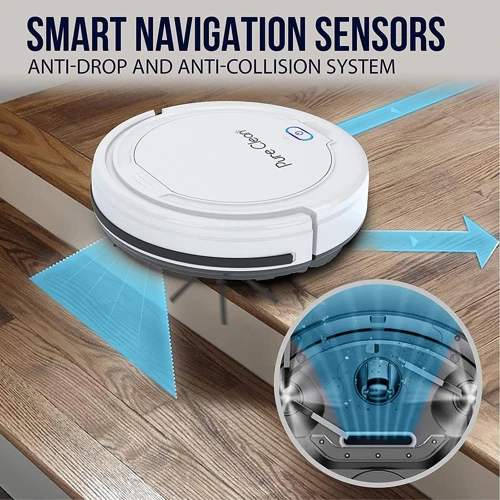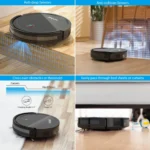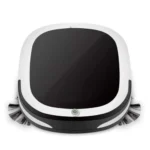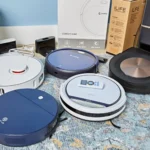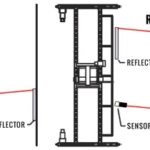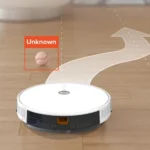As our homes become increasingly smart, we’re seeing more and more household appliances being fitted with advanced technology that makes our lives easier. One such device is the smart vacuum cleaner, which has been a game-changer for homeowners looking to keep their floors sparkling clean without lifting a finger. However, one feature that has been the subject of much discussion is anti-collision sensors. Are they really necessary? Do they add to the cost of the vacuum? In this article, we’ll take a closer look at the pros and cons of anti-collision sensors in your smart vacuum cleaner.
Pros of Having Anti-Collision Sensors
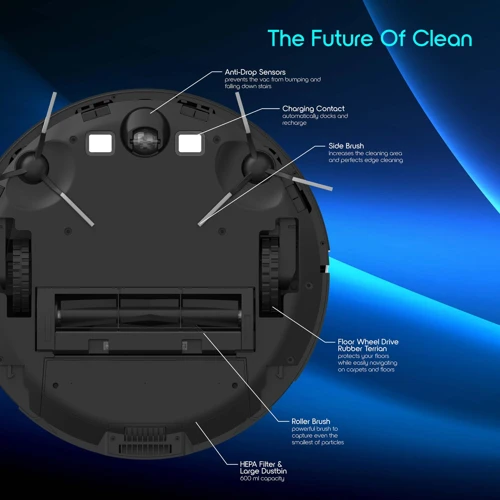
One of the most essential aspects of a smart vacuum cleaner is its ability to navigate around your home with ease. With traditional vacuum cleaners, you’ll need to move your furniture or be more cautious around your home to avoid colliding with walls, furniture, and other household items. However, with the anti-collision sensors integrated into modern smart vacuum cleaners, homeowners can enjoy more convenience and efficiency in their cleaning routine. In this section, we’ll explore the pros of having anti-collision sensors, including preventing damage to your furniture and walls, saving time and effort, and increasing cleaning efficiency.
1. Prevents Damage to Furniture and Walls
Anti-collision sensors are an important feature in smart vacuum cleaners, as they offer a number of benefits to users. One significant advantage is that they prevent damage to furniture and walls.
The way this works is that as the vacuum cleaner moves around the room, the sensors detect any obstacles in its path. When such an obstacle is detected, the vacuum cleaner adjusts its path to avoid it, ensuring that it does not bump into anything. This prevents any damage to the furniture or walls that could occur from collisions.
Having anti-collision sensors in a smart vacuum cleaner can be particularly beneficial for households with small children, pets, or delicate furniture. The sensors help to prevent accidental damage caused by the vacuum cleaner running into obstacles.
Table 1: Benefits of Anti-Collision Sensors in Smart Vacuum Cleaners
| Benefits | Description |
|---|---|
| Prevents damage to furniture and walls | Anti-collision sensors detect obstacles in the path of the vacuum cleaner and adjust its path to avoid collisions, preventing any damage to furniture or walls. |
| Saves time and effort | The sensors help the vacuum cleaner to navigate around the room more efficiently, saving time and effort for the user. |
| Increases cleaning efficiency | Anti-collision sensors allow for more thorough cleaning, as the vacuum cleaner is able to navigate around obstacles and reach more areas. |
However, it is important to note that anti-collision sensors are not foolproof, and there may be instances where the vacuum cleaner still bumps into objects despite the sensors. This can happen if the sensors are not calibrated correctly, if the object is too small to be detected by the sensors, or if there are too many obstacles in the room.
Want to learn more about anti-collision sensors in smart vacuum cleaners? Check out our related articles:
– The Technology Behind Anti-Collision Sensors in Smart Vacuum Cleaners
– Advantages and Limitations of Drop Sensors in Smart Vacuums
– Troubleshooting Anti-Collision Sensors in Smart Vacuum Cleaners.
– Cleaning Tips for Anti-Collision Sensors in Smart Vacuum Cleaners.
– Innovations in Anti-Collision Sensors for the Smart Vacuum Cleaner Market.
– Impact of Anti-Collision Sensors on Different Types of Flooring.
2. Saves Time and Effort
Anti-collision sensors are a game-changer for smart vacuum cleaners. One of the major advantages of having anti-collision sensors in your smart vacuum cleaner is that it saves time and effort during the cleaning process. Let’s take a closer look at how anti-collision sensors make cleaning easier:
| Without Anti-Collision Sensors | With Anti-Collision Sensors |
|---|---|
| Without anti-collision sensors, your vacuum cleaner could run into chairs, tables, bookshelves or other objects resulting in it changing direction or coming to a stop. As a result, you’d have to be present, moving objects out of the way or monitoring the process all the time. | With anti-collision sensors in place, your smart vacuum cleaner will detect obstacles in its path and cease movement or slow down, ensuring that it doesn’t collide with furniture, walls or other objects. You can set your vacuum cleaner to run on its own, confident that it’s not going to cause any damage or miss any areas. |
| Not only does this save you time, but it also reduces the risk of furniture damage or scratches, which means you do not have to constantly keep an eye on the cleaning process | You can relax or work while the cleaning is in progress, which means that your smart vacuum cleaner takes care of cleaning tasks without your intervention, allowing you to use your valuable time for other activities. |
Anti-collision sensors can save you time and effort and make sure that no furniture, walls or other objects are damaged during the cleaning process. Even though anti-collision sensors do add to the cost of your smart vacuum cleaner, the added benefits make them a worthy investment in the long run.
3. Increases Cleaning Efficiency
Anti-collision sensors in smart vacuum cleaners not only prevent damage to furniture and walls, but they also increase the cleaning efficiency. How? Let’s take a look at the following table:
| Scenario | Vacuum Cleaner without Anti-Collision Sensors | Vacuum Cleaner with Anti-Collision Sensors |
|---|---|---|
| Obstacles in the room (e.g. chairs, tables, etc.) | May require manual intervention to prevent collisions and damage | Avoids obstacles and continues cleaning without interruptions, leading to faster cleaning times |
| Small objects on the floor (e.g. toys, socks, etc.) | May get stuck in the vacuum’s brush and require manual removal | Detects the small objects and maneuvers around them, ensuring a thorough clean without any blockages |
| Dark or hidden areas (e.g. under the bed, sofa, etc.) | May require additional cleaning or may be completely missed due to lack of visibility | Detects the dark or hidden areas and adjusts its cleaning path, providing a more comprehensive clean of the space |
As you can see, vacuum cleaners with anti-collision sensors provide numerous benefits which lead to increased cleaning efficiency. With the ability to navigate a room without obstacles, detect and maneuver around small objects, and adjust cleaning paths for dark or hidden areas, smart vacuum cleaners with anti-collision sensors ultimately provide a thorough and stress-free cleaning experience for the user.
Cons of Having Anti-Collision Sensors
While there are many benefits to having anti-collision sensors in your smart vacuum cleaner, it’s important to also consider the potential drawbacks. Here are some limitations and trade-offs to keep in mind before investing in a vacuum with anti-collision sensors. From increased cost to potential issues with reliability, there are factors that may make you reconsider the value of this feature. Let’s explore the cons of having anti-collision sensors in your smart vacuum cleaner.
1. Increases the Cost of the Vacuum Cleaner
One of the major downsides of having anti-collision sensors in your smart vacuum cleaner is the potential increase in its cost. While these sensors are undeniably helpful in preventing damage to furniture and walls, they come at a premium.
Anti-collision sensors can add hundreds of dollars to the price tag of a vacuum cleaner. This is because the sensors themselves are expensive to produce, and the technology required to integrate them into the cleaning mechanism of a vacuum cleaner is also costly. As a result, vacuum cleaners with anti-collision sensors tend to be sold at a higher price point than those without.
To give you a better idea of the cost differences between vacuum cleaners with and without anti-collision sensors, let’s take a look at the following table:
| Vacuum Cleaner Model | Without Anti-Collision Sensors | With Anti-Collision Sensors |
|---|---|---|
| Model A | $150 | $300 |
| Model B | $200 | $400 |
| Model C | $250 | $500 |
As you can see, the cost of a vacuum cleaner with anti-collision sensors can be twice or even more than that of a vacuum cleaner without them. This can be a significant investment, especially for those on a tight budget.
Additionally, the cost of repairing or replacing anti-collision sensors can also be high. If these sensors malfunction or break down, it can be expensive to fix or replace them. This is something to keep in mind when deciding whether to purchase a vacuum cleaner with anti-collision sensors.
Despite the potential increase in cost, many people still believe that anti-collision sensors are worth the investment. However, it’s important to weigh the pros and cons and decide what’s best for your needs and budget.
2. May Not Be Fully Reliable
When it comes to anti-collision sensors in smart vacuum cleaners, we cannot deny the fact that they have revolutionized the way we clean our homes. However, one potential downside to consider is that these sensors may not always be fully reliable.
Why? Well, firstly, these sensors rely on technology and electronics to function properly. Just like any other gadget or device, they may malfunction or fail to work altogether, leaving your vacuum cleaner prone to collisions.
To understand this weakness better, let’s take a look at the following table that highlights some of the major factors impacting the reliability of anti-collision sensors.
| Factors | Impact on Reliability |
|---|---|
| Infrared Sensors | May not detect certain objects |
| Worn-out Sensors | May not provide accurate readings |
| Software Malfunction | May cause the sensors to stop working |
| Overlapping Sensors | May cause confusion and lead to collisions |
As you can see, there are several factors that can affect how reliable anti-collision sensors are in smart vacuum cleaners. These factors can potentially compromise the efficiency and effectiveness of the sensors, leading to collisions with furniture or walls.
What can you do? It’s important to note that not all smart vacuum cleaners are created equal. Some have more advanced technology and features that ensure a higher degree of reliability in their anti-collision sensors. Do your research and read customer reviews before making a purchase to ensure you invest in a quality product.
Another approach is to regularly maintain your smart vacuum cleaner and replace worn-out sensors promptly. This can help prolong the life of your vacuum cleaner and ensure that it remains reliable in the long run.
Conclusion: While anti-collision sensors have made our cleaning routines easier and more efficient, we should also be aware that they are not infallible. It is advisable to weigh the pros and cons of having these sensors in your smart vacuum cleaner and take preventative measures to ensure they remain reliable.
3. Limits Flexibility in Cleaning
One of the potential drawbacks of having anti-collision sensors in your smart vacuum cleaner is that it may limit the flexibility of its cleaning ability. While these sensors prevent the vacuum cleaner from colliding with furniture and walls, they may also prevent it from reaching certain areas.
Here are a few examples:
- Narrow Spaces: Anti-collision sensors in your smart vacuum cleaner may not allow it to clean narrow spaces efficiently. These sensors may prevent the vacuum cleaner from moving close enough to clean under furniture with narrow legs, or in tight corners.
- Low Furniture: Similar to how anti-collision sensors could prevent the vacuum cleaner from cleaning narrow spaces, they may also limit the ability to reach under low-lying furniture. The vacuum cleaner may avoid these areas, as the sensors detect the furniture as an obstacle and divert its path.
- Stuck Objects: If the sensors detect an object lying on the floor, it may prevent the smart vacuum cleaner from approaching it. This could cause the vacuum cleaner to miss a spot, and may require manual intervention to remove the obstacle, frustrating the user.
While anti-collision sensors can prevent damage to furniture and walls, it’s important to keep in mind that they may also limit the flexibility of your smart vacuum cleaner. Depending on your home’s layout and furniture, this may cause some areas to be left uncleaned.
Conclusion
After analyzing the pros and cons of having anti-collision sensors in your smart vacuum cleaner, it is clear that the benefits outweigh the drawbacks. The preventive measures offered by these sensors not only prevent damage to your furniture and walls, but also save both time and effort while increasing the cleaning efficiency of your vacuum cleaner. However, the added cost and potential reliability issues are valid concerns to keep in mind.
If you are someone who values keeping your home clean and damage-free, the addition of anti-collision sensors may be worth the investment. Not only will it provide peace of mind, but it will also allow you to save time and effort while still ensuring that your home is clean.
Overall, it is important to weigh the pros and cons and determine whether the addition of anti-collision sensors is right for you and your cleaning needs. As technology and innovation continue to evolve, it is likely that these sensors will become even more reliable and flexible, making them an even more attractive option for consumers.
Frequently Asked Questions
How do anti-collision sensors work in smart vacuum cleaners?
Anti-collision sensors work using a combination of infrared and ultrasonic technology to detect obstacles in the vacuum cleaner’s path.
Do all smart vacuum cleaners have anti-collision sensors?
No, not all smart vacuum cleaners come equipped with anti-collision sensors. It is important to check the product specifications before making a purchase.
What types of obstacles can anti-collision sensors detect?
Anti-collision sensors can detect furniture, walls, and other large obstacles in a vacuum cleaner’s path.
Can anti-collision sensors prevent damage to the vacuum cleaner itself?
In most cases, anti-collision sensors are designed to prevent damage to furniture and walls, but not necessarily the vacuum cleaner itself.
Can anti-collision sensors be turned off?
Generally, no, anti-collision sensors cannot be turned off. However, some models may have a “manual mode” option that allows the user to bypass the sensors.
Do anti-collision sensors work well in low-light conditions?
Most anti-collision sensors require a certain level of light in order to operate effectively. If the room is too dark, the sensors may not work properly.
Does the thickness of a carpet or rug affect anti-collision sensor performance?
Sometimes, yes. Thick or shaggy carpets and rugs may interfere with the sensors, causing the vacuum cleaner to either avoid the area completely or collide with the obstacle.
Are anti-collision sensors easy to clean?
Yes, anti-collision sensors are generally easy to clean. Most vacuum cleaner models come with a brush or cleaning tool that can be used to remove any debris that may have accumulated on the sensors.
Do anti-collision sensors make a smart vacuum cleaner louder?
Not necessarily. The noise level of a smart vacuum cleaner is determined by several factors, including the size of the motor and the design of the brush roller.
Do anti-collision sensors require regular maintenance?
No, not typically. Anti-collision sensors are designed to be durable and reliable, and should not require any regular maintenance beyond simple cleaning.
